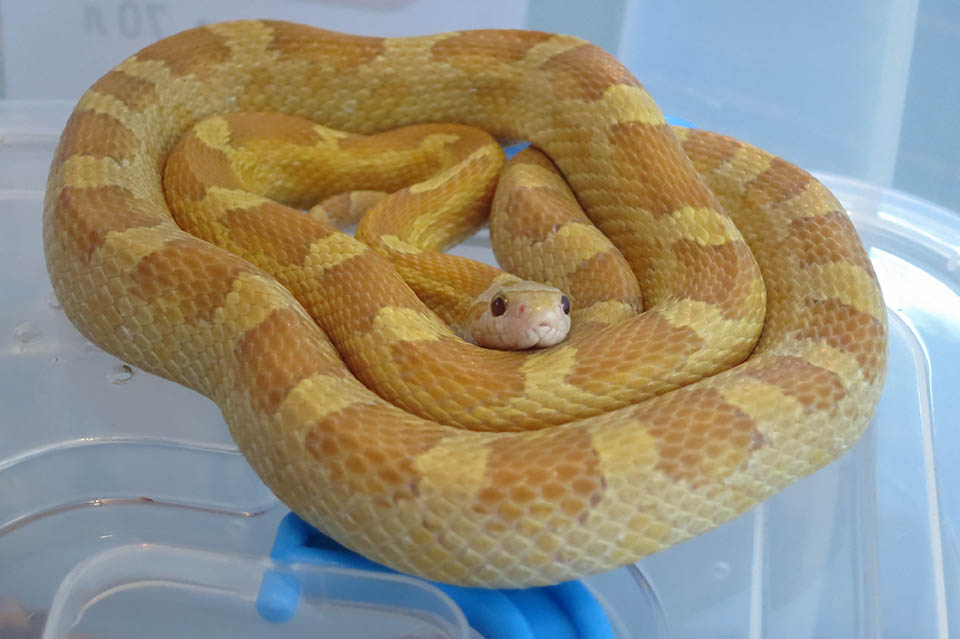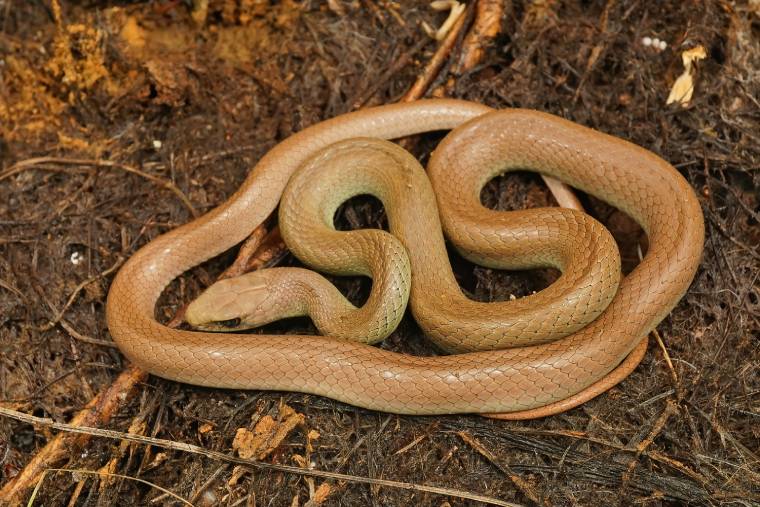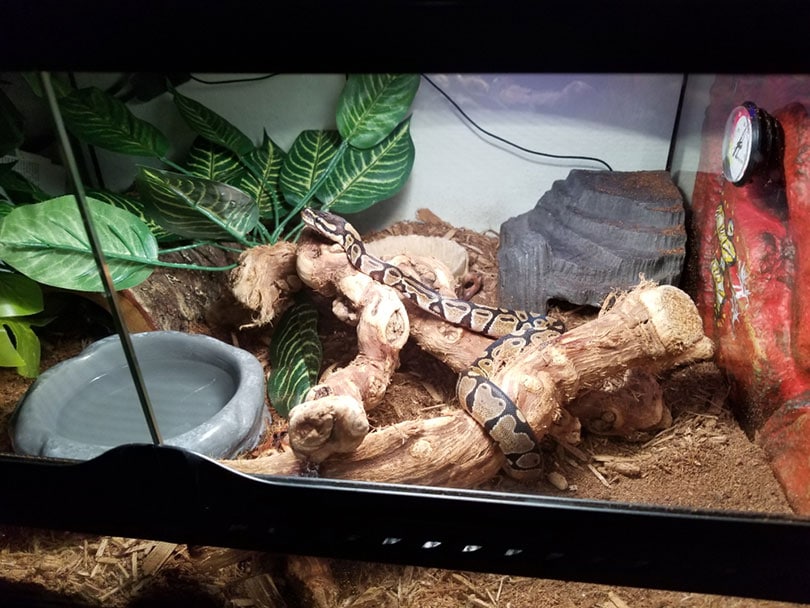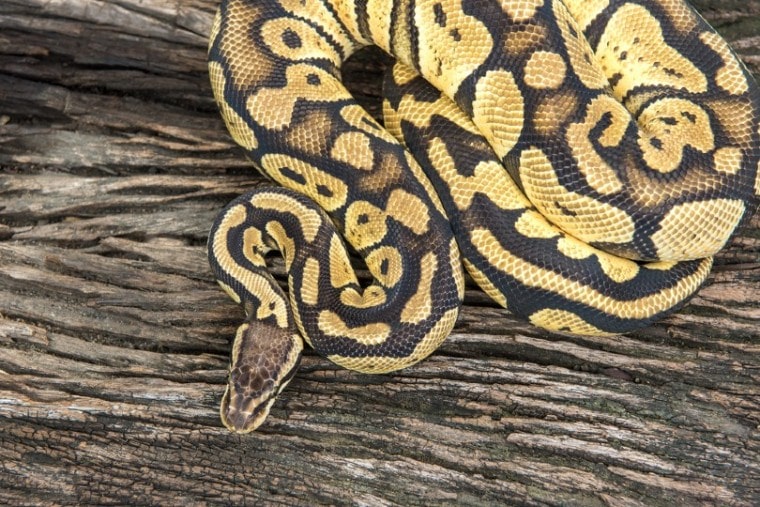
Click to Skip Ahead
Ball pythons are incredibly popular pet snakes for a variety of reasons. Not only do they reach an impressive but manageable size when fully grown, but they are very calm, easy to handle, and come in a wide variety of color and pattern morphs.
Ball python morphs are the result of the selective breeding of animals with certain genetic mutations. Anyone interested in a ball python will have plenty of options to choose from. Today, we are going to talk more about the morph known as the Mystic ball python, which has a gene that alters both the pattern and color.
| Size: | 2–5 feet |
| Weight: | 1,200 to 2,500 grams |
| Lifespan: | 20–30 years |
| Similar Morphs: | Phantom, Mojave, Lesser Platinum, Bamboo, Butter |
| Suitable for: | All experience levels |
| Temperament: | Docile, shy, easy to handle |
The Mystic ball python is an incomplete dominant mutation that was first discovered by Anthony McCain in 2005. This mutation is fairly common, can alter both the color and pattern of the snake and is used to create numerous other combinations.
Mystics do carry the same allele as several other morphs including the Mojave, Phantom, Lesser Platinum, Bamboo, Butter, and more, but the results are quite different.
Regular Mystic ball pythons look like the Mojave morph with black to dark brown bodies with light blushing but have burnt orange flames that provide a vibrant contrast. Their heads are often light brown and more triangular than your average ball python with little to no blushing. The tail also features minimal blushing with the same coloration of the rest of the body.
These snakes reach the same size as any other ball python, ranging from 2 to 5 feet in length and reaching anywhere from 1,200 to 2,500 grams when fully grown. Though individual temperaments are subject to vary, ball pythons in general are quite docile and great for keepers of all experience levels.
Mystic Ball Python Characteristics
How Much Do Mystic Ball Pythons Cost?
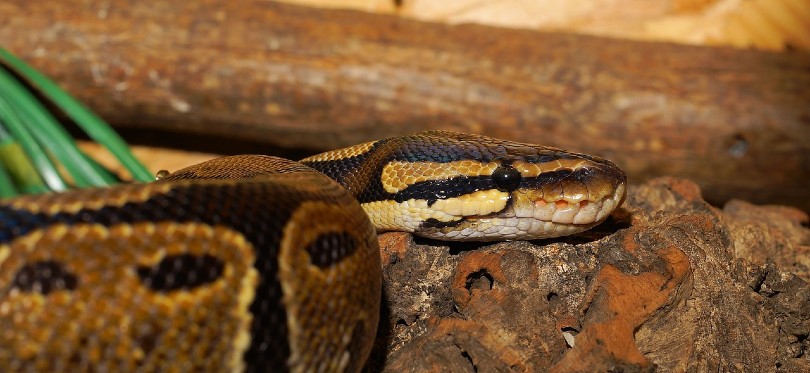
Having been produced since 2005, the Mystic ball python is a more common and readily available morph that typically costs anywhere between $100 and $300. Throughout the years, there have been many combinations created from this morph, with the most popular being Mystic Potion, Mystic Crystal, Super Mystic, Mystic Pin, Mystic Russo, and the Enchi Mojave among many others. These combinations can range in price from $100 up to $5,000 or more.
Temperament & Behavior of the Mystic Ball Python
Ball pythons are known for being docile and easy to handle, which is one of several reasons why they are among the most popular snakes in the pet trade. They are a shy, reclusive species that spend most of their time within the comfort of their hides. Young ball pythons are often more timid and wary of humans but can easily become more tolerable of human contact with regular, safe handling.
Snakes do not require any social interaction for their mental health and will not form bonds with their owners. Handling can cause them a great deal of stress, so keepers should aim to handle no longer than 10 minutes each time.
To prevent stressing your Mystic ball python out too much, avoid handling 1 to 2 days prior to feeding and for 2 to 3 days afterward. Also, avoid handling as they are approaching a shed. During this time their vision is impaired, and they feel much more vulnerable, and handling can stress them out severely.
Do These Snakes Make Good Pets?
Ball pythons have the potential to make excellent pets for any keeper that understands the species and can provide proper care and husbandry. They are often a great pet snake for beginners but are kept by keepers of all experience levels. The downside to ball pythons is that they tend to be picky eaters, which can be problematic for some of the more novice keepers.
Can They Be Kept with Other Snakes?
Ball pythons are not social creatures and should not be kept with any other animal, including other ball pythons. Since they live a solitary lifestyle in the wild, this should also be reflected in a captive environment.
Things to Know When Owning a Mystic Ball Python:
Food & Diet Requirements
Ball pythons are nonvenomous constrictors that require a diet of whole prey, primarily rats or mice. It is recommended they are fed frozen-thawed, appropriately sized prey items that are no larger than the widest part of the snake’s body. This helps promote easy digestion and prevents regurgitation of oversized prey.
Ball pythons can be picky eaters and may imprint on a particular food source. This can be more troublesome if they imprint on mice but then grow to their adult size in which rats are the most ideal meal. In some cases, you may have to begin offering mice, but then make the switch to rats as soon as possible.
You should only offer your snake captive bred feeder rodents that have been humanely killed. Live prey is not recommended since they will defend themselves and can cause harm to the snake by biting and scratching. Not only can this result in wounds but it also puts the snake at risk of infection and will leave you with a vet bill.
If you run into trouble with a ball python eating frozen thawed prey, try spacing out the feeding an additional week to entice their appetite. In cases where keepers choose to feed live, the animal should never be left unattended with the snake and should be removed right away if the snake shows no interest in eating.
Baby and juvenile Mystic ball pythons will typically eat every 1 to 2 weeks, while adults can be fed once every 2 to 4 weeks. Always contact your veterinarian if you have any questions regarding your snake’s diet or feeding schedule.
Habitat Requirements
Enclosure Type
Ball pythons can be kept in a variety of enclosures. There are many options on the market, but it’s always a good idea to opt for a terrarium that is built for reptiles and designed to accommodate the essential heating mechanisms that keep the environment properly regulated. Ball pythons will escape if given the chance, so the habitat must be secure.
Size
It is highly recommended that ball pythons be kept in an enclosure that is suited for their current size. Putting baby or young ball pythons in a smaller enclosure will allow them to feel safer and more secure within the habitat. As the snake grows, you can increase the size of the enclosure.
Substrate
There are several types of substrates that can be used in your Mystic ball python’s enclosure. Coconut fiber, aspen chips, cypress mulch and fir bark are among the most popular, though some keepers choose to keep them on newspaper or paper towels.
Cedar should never be used because the oils and fumes are highly toxic to snakes and other reptiles. Sand should also be avoided since it is easy to ingest during feeding and can lead to a danger impaction.
Enclosure Accessories
There should always be two size-appropriate hides available within a ball python’s enclosure. One should be located on the cool side and the other on the designated warm side. You should also have a water dish filled with fresh, clean water. These are the necessities, but you can also choose to add other décor that can assist with shedding or for the aesthetic.
Temperature and Humidity
Ball pythons do not require special lighting like most other species of pet reptiles, but keeping their environment within the appropriate temperature and humidity range is essential for their overall health and longevity.
Temperature Needs
There should be a dedicated warm side and a dedicated cool side in a ball python’s enclosure with a hide on each. A heating mat, heating tape, or built in radiant heat panels are among the best ways to heat the enclosure. A thermostat should be used to monitor the temperature on each side.
The warm side should be kept between 85 and 91 degrees Fahrenheit and never exceeding 93 degrees. The cold side should be kept around 80 degrees Fahrenheit and never below 75 degrees. This balance should maintain the ambient temperature of the enclosure around 82 degrees Fahrenheit.
Humidity Needs
Ball pythons require around 60 percent humidity within their environment, though babies may benefit from slightly higher levels. This can be monitored with a hygrometer and easily maintained by keeping the water dish full of fresh clean water, occasionally misting the enclosure, or by slightly dampening the substrate. Proper humidity is important for successful shedding and maintaining optimum health.
Exercise & Sleeping Needs
Ball pythons are nocturnal creatures that are typically active from dusk until dawn. As pets, they do not have to seek out food sources and are relatively inactive. You will notice that they spend most of their time nestled securely under their hide.
While they do not require any special lighting, it’s a good idea to keep them on a regular night and day cycle. Make sure the room they are in gets plenty of natural light during the day and you turn off the lights when it gets dark at night.
Lifespan and Health Conditions
The average life expectancy for a ball python in the wild is 10 to 15 years while captive specimens can live up to 30 years or more with proper care and husbandry. Their lifespan is extended significantly in captivity since they are not at risk of being preyed upon.
These snakes are very hardy, but there are certain health conditions that keepers should be aware of. Thankfully, all these health problems are easily avoided if their temperature, humidity, cleanliness, and dietary needs are met.
Common Health Conditions:
Respiratory Infection
Respiratory infections are a result of improper environmental conditions and are typically caused by the enclosure being kept cold or having too high humidity. One of the most common signs of a respiratory infection is wheezing, but other signs include open mouth breathing, gurgling while breathing, and discharge from the nostrils. Keepers should seek veterinary care right away, as respiratory infections can be deadly.
Mites
Mites are parasites that affect snakes and will often hide within the grooves of the scales and on the underside of the jaw. Mites reproduce quickly and keepers should take the necessary steps to treat the problem quickly, as severe infestations can result in anemia and even death. One of the common behaviors exhibited by snakes suffering from mites is excessive soaking in the water dish.
Dysecdysis
Dysecdysis refers to issues with the natural process of shedding the skin. Shedding occurs throughout a snake’s entire life and occurs as they grow. An incomplete or stuck shed can easily occur because of improper humidity levels or a lack of accessories to aid in the process.
Scale Rot
Scale rot is a term used to describe issues with the skin or scales and includes conditions such as dermatitis, abscesses, burns, abrasions, and secondary infections. Scale rot is often the result of poor husbandry and should be treated by a veterinarian promptly.
Male vs Female
When it comes to temperament, there aren’t any noticeable differences between male and female Mystic ball pythons. The biggest difference between the sexes is the mature size. Females will often get much larger than males, reaching 3 to 5 feet in length and weighing up to 2,500 grams. Males typically max out between 3 and 3.5 feet and 1800 grams.
Sexing a ball python is best left to those with experience, such as veterinarians and reputable breeders. The male reproductive organs, or hemipenes, are stored inside the tail and are very difficult to confirm through observation alone.
3 Little-Known Facts About the Mystic Ball Python
1. Ball Pythons Are Native to Africa
The Ball python, known scientifically as Python regius, are the smallest species of African python and are native to the West and Central areas of the continent where they inhabit the grasslands, savannas, and open wooded areas. They are also referred to as the royal python, as they are revered by local cultures and considered sacred symbols of the earth.
2. The Name Ball Python Comes from a Defensive Behavior
The name Ball python comes from their popular defensive behavior of curling up in a ball with their heads tucked beneath their body when they feel threatened or stressed. They also curl tightly into a ball when in the comfort of their hides.
3. Baby and Juvenile Ball Pythons Are More Vibrant
There are many incredible morphs within the ball python pet trade but regardless of what kind of morph the snake is, baby and juvenile specimens are often much more vibrant. These vibrant colors often fade as they age and grow.
Final Thoughts
Mystic ball pythons are the result of an incomplete dominant gene mutation within the species. The gene alters both color and pattern and is used in a wide variety of combinations to create other beautiful and unique morphs. Like all ball pythons, Mystics are often calm and easy to handle, making them great for all experience levels. They make great pets for those prepared to meet their care and husbandry needs throughout their entire lives.
See also:
- Harlequin Ball Python Morph: Traits, History, & Care (with Pictures)
- Sunset Ball Python Morph: Facts, Info & Care Guide (with Pictures)
Featured Image Credit: February Sweet, Shutterstock

